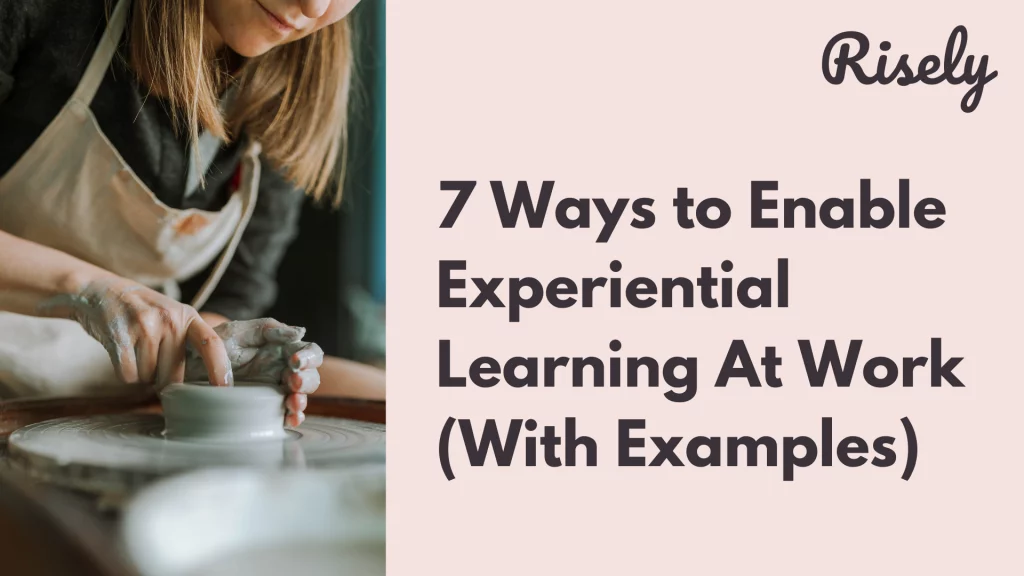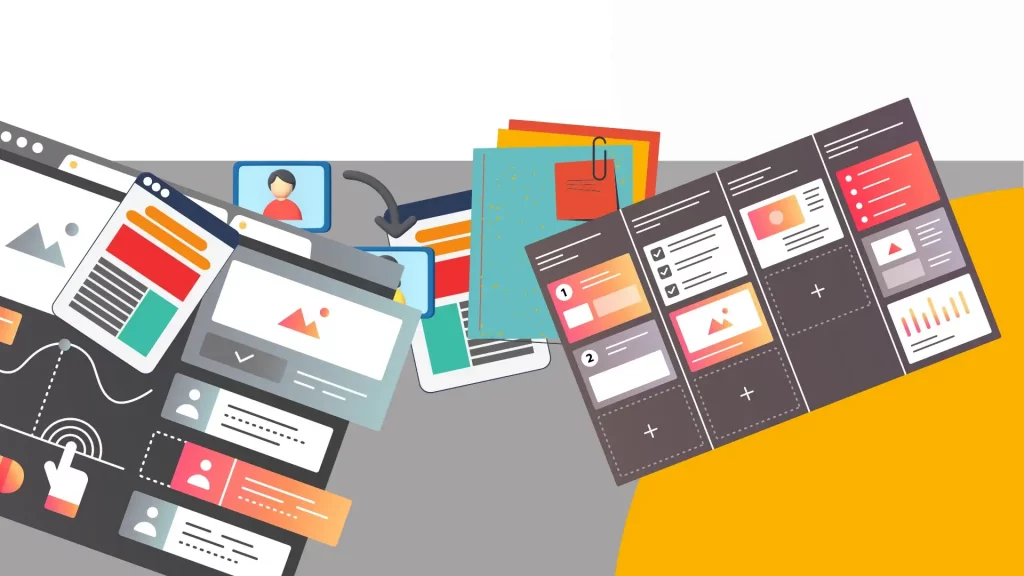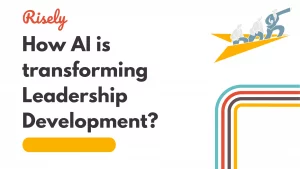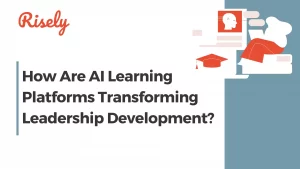What is Experiential Learning?
Experiential learning is using hands-on experiences and reflection to gain knowledge and skills. It involves actively participating in tasks or projects that offer practical learning opportunities. This approach enhances retention and skill development by enabling learners to apply their knowledge in real-life situations. Simulations, on-the-job training, internships, and apprenticeships are all examples of learning by experience.Types of Experiential Learning
The approach where individuals learn through direct experiences and observation involves steps like reflection, feedback, and applying knowledge gained through such experiences. It can take many forms, such as:- Job Shadowing: Employees can observe and learn from more experienced colleagues by shadowing them daily. It allows for firsthand exposure to different tasks, processes, and decision-making.
- Cross-Functional Projects: Employees are assigned to work on projects or initiatives that involve collaborating with individuals from various organizational departments or functions. It exposes diverse perspectives, fosters teamwork, and promotes learning through collaboration.
- Stretch Assignments: Employees are given assignments or projects that challenge them to go beyond their current skill set or comfort zone. These assignments provide opportunities to develop new skills, tackle complex problems, and broaden expertise.
- Simulation Exercises: Workshops or training programs incorporate simulated scenarios replicating real-life work situations. Participants engage in role-playing, problem-solving, and decision-making exercises to gain practical experience and develop skills in a safe and controlled environment.
- Action Learning Projects: Teams or individuals are tasked with solving real business problems or addressing the organization’s specific challenges. They work collaboratively to research, analyze, and implement solutions, learning through practical application and reflection.
Benefits of Experiential Learning
Through experiential learning opportunities such as simulations, role-playing exercises, on-the-job training programs, internships, or apprenticeships in the workplace or at an academic institution, employees can experiment with new ideas while developing effective problem-solving strategies. Such engaging forms create a great employee experience in teams. This type of learning encourages creativity and innovation, which can lead to the development of new business models or products. Employees who participate in experiential learning activities can also improve their communication skills by working with others on group projects or participating in team-building exercises. As a result of these experiences, learners often gain much-needed self-confidence and improved competencies in various business skills.Enhanced Learning Experience
Active engagement in the learning process through enhanced learning leads to applying theoretical knowledge in real-world situations while promoting critical thinking skills. Problem-solving is encouraged within a team-oriented collaborative environment that emphasizes a hands-on approach for better understanding and clearer knowledge retention in the long term. Encouraging creativity and innovation is crucial within a practical experience based on reflective observation and experimentation that incorporates new ideas. Using the experiential learning cycle by David Kolb provides a structured way for learners at any level of education or work experience to achieve these competencies using their past experiences as a foundation for future growth.Improved Retention and Application
Experiential learning offers active participation and enhances the learning experience’s quality through improved retention and application of knowledge. An essential aspect of this method is fostering collaboration with colleagues while promoting problem-solving abilities. Employees can develop critical thinking skills by evaluating their experience-based decisions. Experience-based learning can also lead to a more engaged workforce by creating opportunities for self-reflection on past experiences. The approach encourages hands-on activities that allow learners to experiment with new ideas as they move through the stages of David Kolb’s experiential learning cycle – concrete experience, reflective observation, abstract conceptualization, and active experimentation – as described in Dewey’s experiential education theory.Building Critical Thinking and Problem-Solving
Developing critical thinking and problem-solving skills is crucial for success in any workplace. It provides an excellent opportunity to enhance these competencies by enabling learners to apply theoretical knowledge in real-world situations. By engaging in experimentation through simulations, role-playing exercises, and case studies, employees can gain new ideas and insights that can be applied to their work. Implementing the learning cycle proposed by David Kolb or John Dewey’s approach to situated learning can also help learners develop reflective observation skills that lead to better decision-making and higher self-confidence.7 Ways L&D Can Implement Experiential Learning at Work (with Examples)
L&D professionals can leverage experiential learning to create a dynamic and engaging employee learning environment. Here are seven ways to implement it:1. Project-Based Learning
Project-based learning assigns employees real-world projects that require collaboration among the participants, problem-solving, and application of newly learned skills. This method allows them to take ownership, make decisions, and experience the consequences of their actions in a safe environment.The marketing team needs to develop a social media campaign for a new product launch. L&D can design a project in which employees are divided into teams. Each team is responsible for researching target audiences, brainstorming creative content formats, and developing a campaign strategy. This allows them to apply marketing principles, collaborate, and solve problems in a real-world context.
2. Gamified Simulations
Gamified simulations utilize game mechanics and elements like points, badges, and leaderboards to engage learners in simulated scenarios. This approach allows employees to practice skills and decision-making in a safe, controlled environment while fostering healthy competition and motivation.The sales team is struggling to handle customer objections. L&D can create a gamified simulation where employees role-play as salespeople facing different customer objection scenarios. Points can be awarded for effectively addressing objections and closing deals. This provides a safe environment to practice communication and negotiation skills while incorporating a fun element.
3. Case Study Challenges
Case study challenges present employees with real-world business dilemmas or situations. Teams analyze the scenario, discuss potential solutions, and defend their choices based on relevant business principles. This method encourages critical thinking, problem-solving, and public speaking skills in a collaborative setting.The leadership team needs to improve their decision-making skills. L&D can present real-world business case studies with ambiguous situations. Teams can analyze the scenario, discuss potential solutions, and defend their choices based on relevant business principles. This fosters critical thinking, problem-solving, and public speaking skills.
4. Job Shadowing and Mentorship
Job shadowing pairs less experienced employees with mentors for on-the-job observation and skill development. The mentee observes the mentor’s daily tasks, asks questions, and gains practical experience in a real-world setting. This approach fosters knowledge transfer, builds confidence, and allows transfer of constructive feedback.A new data analyst needs to gain practical experience. L&D can facilitate job shadowing, where the new employee observes a senior data analyst for a week. The mentor can then guide the new employee through a real-world data analysis project, offering hands-on experience and personalized feedback.
5. Volunteer Work and Service Learning
Volunteer work and service learning allow employees to apply their skills while giving back to the community. Partnering with local NGOs will enable employees to engage in projects aligning with the company’s values and skillsets. This approach develops empathy and teamwork skills and fosters a sense of purpose and community within the workforce.The company wants to cultivate social responsibility within its employees. L&D can partner with local NGOs to arrange volunteer opportunities. Employees can participate in projects aligning with the company’s values and skillsets. This develops empathy and teamwork skills and fosters a sense of purpose and community within the workforce.
6. Internal Knowledge Sharing Sessions
Internal knowledge sharing sessions leverage the expertise within your organization. Subject matter experts can present their knowledge and experience on relevant topics, allowing colleagues to learn from each other in an interactive setting. This fosters a culture of collaboration and knowledge exchange while promoting internal talent expertise.The engineering team is implementing a new software program. L&D can identify employees who have successfully mastered the program and invite them to lead a knowledge-sharing session for the team. This allows colleagues to learn best practices directly from an internal expert and ask questions in a familiar environment.
7. Reverse Mentoring Programs
Reverse mentoring programs pair senior employees with younger employees with expertise in digital technologies or emerging trends. Senior leaders can gain new perspectives and stay current with technological advancements while fostering a culture of mutual learning and intergenerational collaboration.The company leadership team wants to better understand social media marketing trends. L&D can develop a reverse mentoring program pairing them with younger social media savvy employees. This allows leadership to learn about the latest platforms and strategies from a younger generation while providing valuable career development opportunities for junior employees.
To Wrap Up!
Experiential learning is a powerful way to engage employees, build skills, and drive business results. Not only does it provide a learning experience that is more engaging and memorable, but it also has a proven track record of improving retention rates, building critical thinking skills, and fostering problem-solving abilities. By creating a safe and supportive environment for learning, you can help your team members grow and thrive while contributing meaningfully to your organization’s success. To learn more about implementing experiential learning in the workplace and how to evaluate its success, check out our comprehensive guide on 7 ways to enable experiential learning at work.Share and gather feedback effectively to create great learning experiences.
Test your constructive feedback skills with our free assessment now to learn more about your skills.
What is experiential learning and examples?
What is the purpose of experiential learning?
Field trips: Visiting museums, historical sites, or industry-related locations to immerse in hands-on learning.
Internships or work placements: Gaining practical experience in a professional setting to apply academic knowledge.
Simulations or role-plays: Engaging in simulated scenarios to practice problem-solving, decision-making, or teamwork.
What are the 4 stages of experiential learning?
Concrete Experience: Engaging in a real or simulated experience that forms the basis for learning.
Reflective Observation: Reflecting on the experience and examining the observations, thoughts, and emotions associated with it.
Abstract Conceptualization: Analyzing and making sense of the experience by connecting it to existing knowledge, theories, or concepts.
Active Experimentation: Applying the insights gained from reflection and conceptualization to new situations or challenges and experimenting with different approaches or actions.






